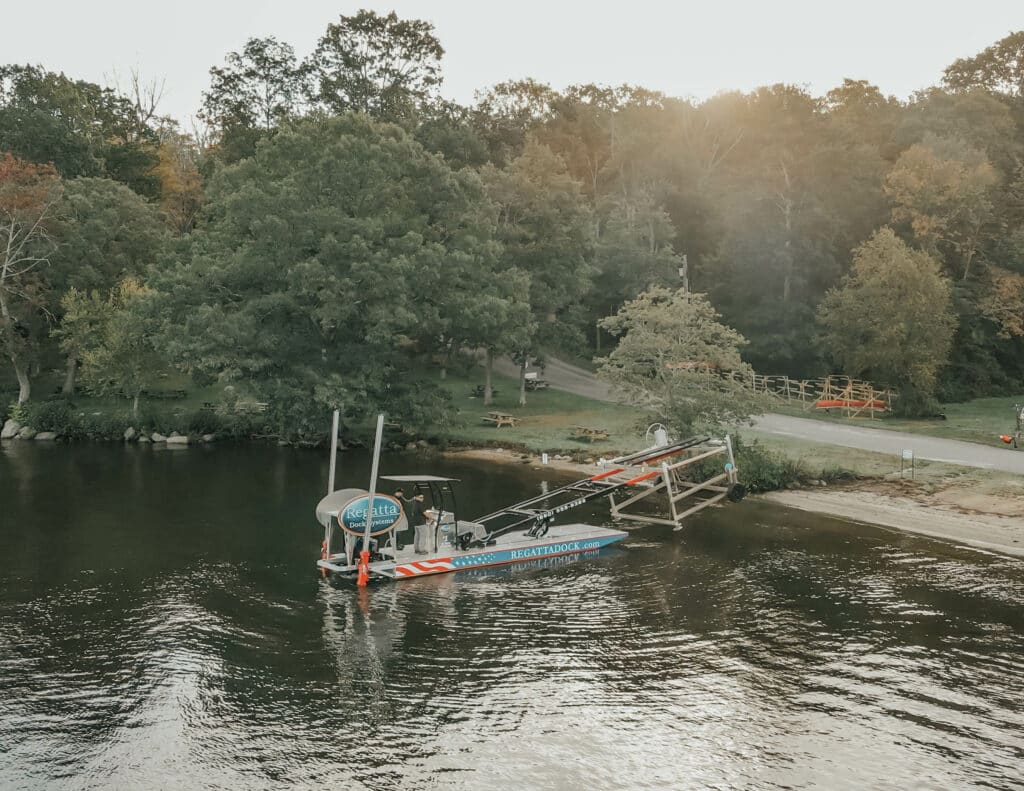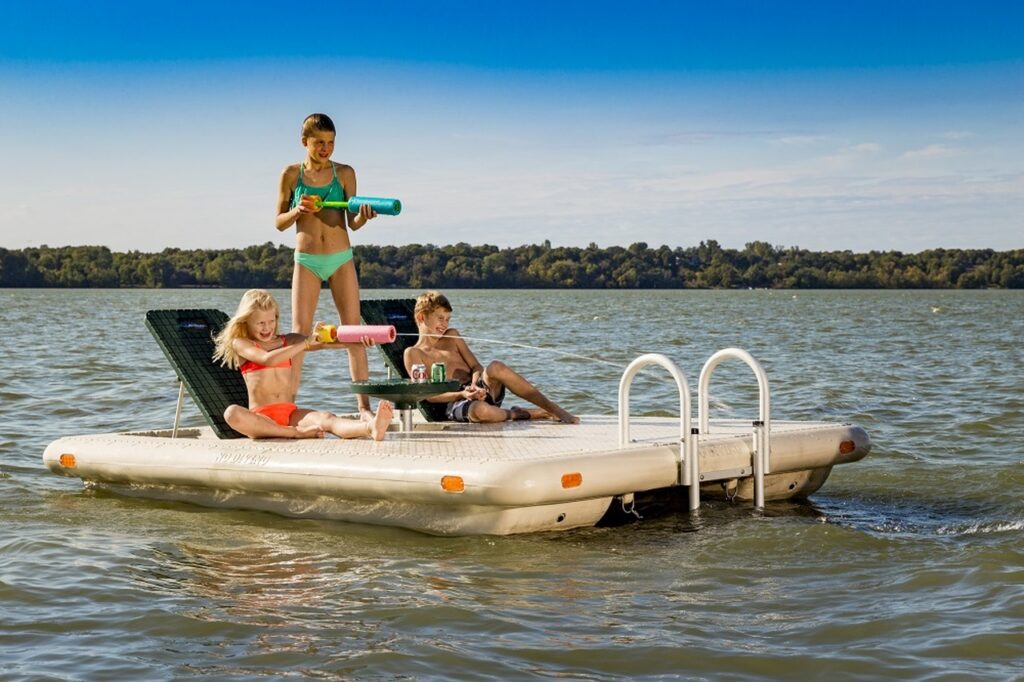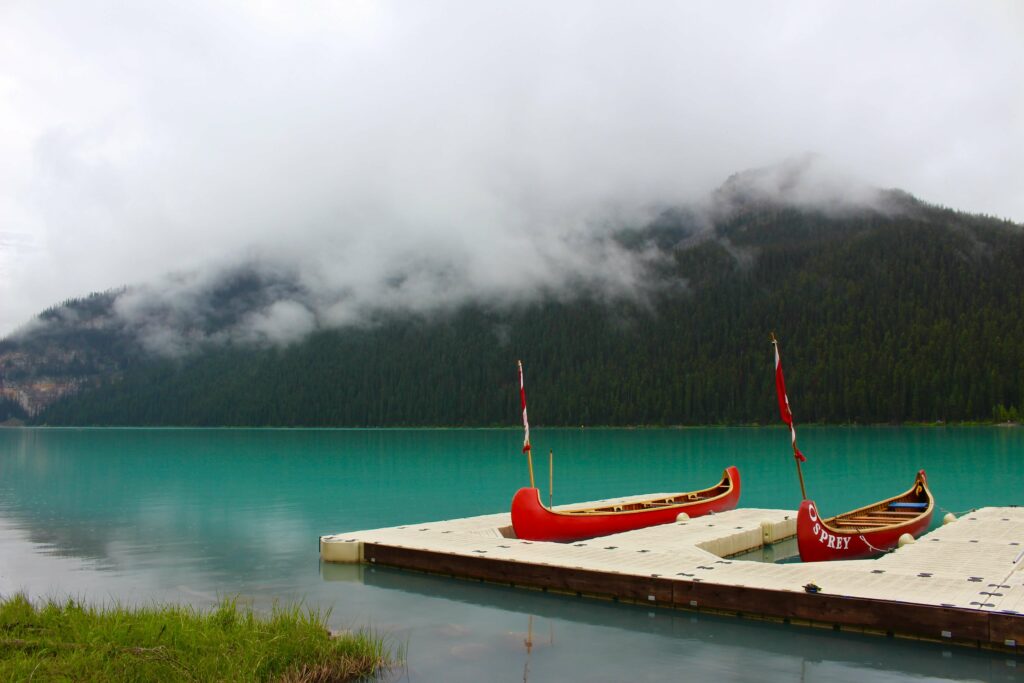This post was updated in November 2024 to include the latest information.
Installing a modular floating or permanent dock system is a fantastic way to maximize enjoyment of your waterfront property, whether for docking boats and personal watercraft or simply lounging on the water all summer long. But when the seasons change, you still have to figure out what to do with your dock in the winter.
Strong winds, surging waves, storm activity, and freezing temperatures can all conspire to damage both permanent and floating dock systems. While you’re diving into a pumpkin spice latte, your dock could be bowing under the weight of snow and ice, and pilings could be getting roughed up by ice floes before the surface has fully frozen over.
So, what can you do to make sure your boat dock, gangway, PWC ports, or other docking structures remain in good condition throughout the winter months so that they’re ready for use when warmer temperatures return? Here are a few guidelines to help you prep for cold weather and winterize your dock.
Effects of Winter Weather on Dock Materials
Different dock materials respond differently to winter weather conditions, and the impact of snow, ice, and water fluctuations varies across material types. While aluminum docks offer excellent resistance to corrosion, heavy snow and ice accumulation may lead to bending or warping if left unchecked. Wood docks, although beautiful, can be susceptible to rot, splitting, or swelling as temperatures drop and moisture levels rise.
For composite docks, freezing temperatures generally pose less of a problem, as these materials are often engineered to withstand moisture and cold. Still, even durable materials can suffer damage if exposed to ice floes or freezing water levels over extended periods. Understanding your dock’s materials will help you tailor your winter preparation steps to keep it safe and sound until spring.
Floating Dock Removal
Floating docks are an efficient way to get out on the water, offering a cost-effective alternative to permanent docks. However, because they’re held in place by anchors, they are more vulnerable to the effects of harsh weather.
If you live in an area that experiences severe winter storms, high winds, or if the lake freezes over, removing the dock for winter is your best bet. Removing floating docks is also recommended in lakes where water levels drop significantly during the off-season or in municipalities that drain lakes in winter.
When it comes to storage, modular docks with interlocking sections should ideally be removed to an enclosed storage area, such as a boathouse or shed. This will shield your dock from the elements, preserving its lifespan. If enclosed storage isn’t possible, securing dock sections on the shoreline can also work. Covering them with a weighted tarp can stave off some environmental damage, but it’s essential to ensure that any dock sections stored onshore are clearly marked to avoid posing hazards to snowmobilers or other winter-sport enthusiasts.
Leaving a Floating Dock in the Water
There are instances in which you can save yourself some trouble by simply leaving a floating dock in the water during the winter. If it doesn’t get cold enough for water to freeze solid, your dock area will be sheltered from wind and wave activity. If the water level remains high enough that dock sections won’t come into contact with rocks below, you may be able to safely leave it in the water year-round.
However, you should still take precautions to keep it as safe as possible when you leave it sitting for the winter. First, remove all ramps and ladders that could come loose in a storm. Next, account for potential shifts in water levels by adding some slack to the anchor lines. This could also help the dock to shift if it gets hit by ice floes.
You might also want to secure the dock to a solid object on land to keep it from floating away if anchor lines become damaged. Finally, make sure your dock is clearly marked, ideally with lighting, so others on the lake can avoid running into it.
Winterizing a Permanent Dock
Not all docks can be removed seasonally, particularly if you have a permanent installation. For these docks, de-icing or dock bubbling systems can be extremely effective in preventing ice damage.
De-icing systems, typically installed in water 12 feet deep or more, work by pulling warmer water from the lakebed to the surface. This keeps the area around your dock ice-free, protecting pilings and the dock structure itself. For shallower areas, dock bubblers are an ideal solution. These systems use an air compressor on the shore to force bubbles through a diffuser line along the dock, maintaining water movement that discourages freezing.
If you choose either of these systems, consider putting up signage to warn others of their presence—de-icers and bubblers create open water areas that can be hazardous without warning.
Connecticut-Specific Winterization Challenges
Waterfront properties in Connecticut face unique winterization challenges due to the region’s variable climate and distinct geographical features. Here are some key considerations:
- Coastal Dock Considerations
- Connecticut’s coastal areas face extra challenges from saltwater exposure, tides, and powerful nor’easters. For docks exposed to saltwater, anti-corrosion treatments are essential, and coastal docks often require more robust anchoring systems to withstand storm surges. If you’re along the coast, consider consulting a professional to assess your dock’s stability and resilience against tidal forces.
- Fluctuating Lake and River Levels
- Inland lakes and rivers in Connecticut often experience seasonal changes in water levels, which can cause floating docks to shift or come into contact with underwater rocks. Choosing a de-icing system is particularly useful in fluctuating waters, as it helps prevent ice from damaging the dock if water levels suddenly drop. Make sure to adjust anchor lines regularly to accommodate changes in lake height.
- Heavy Snow and Ice Buildup
- Connecticut winters are known for unpredictable snowfalls, which can lead to heavy snow and ice accumulation on docks. This buildup increases weight on the dock, which can lead to warping or even structural damage. Regularly clearing snow from accessible docks or choosing a de-icer with enough power to manage freezing around your dock’s pilings can go a long way in preventing these issues.
- Winter Storm Prep and Monitoring
- Winter storms in the region are often accompanied by strong winds and rough waters. Ensure that floating docks left in the water are sheltered or anchored in protected areas to reduce exposure to rough waters. When in doubt, temporary removal is often the safest choice.
By understanding and preparing for these Connecticut-specific challenges, you can keep your dock in peak condition for spring and summer.
Essential Pre- and Post-Winter Dock Inspections
Thorough inspections before and after winter are crucial for spotting potential issues early. Begin your pre-winter inspection in fall by checking for rust, cracks, or loose bolts. If you notice any signs of wear or damage, address them before winter to prevent minor issues from worsening under ice and snow pressure. Once spring arrives, conduct a second inspection to confirm that all dock components are intact and functional.
These seasonal checks will help ensure that your dock is ready for safe use when warm weather returns, while also extending its lifespan.
Dock Winterization Timeline
Planning ahead for dock winterization can save you both time and stress, especially if the weather turns harsh sooner than expected. Here’s a seasonal breakdown of recommended steps to help you stay on track:
- September to October: Early Preparations
- Begin by inspecting your dock for any signs of wear or damage after a busy summer season. Look for loose bolts, cracks in planks, or rusted metal that may need repair before winter.
- Decide on your storage strategy: Are you planning to remove the dock, or will you keep it in the water? Early fall is an ideal time to schedule removal with a professional service if needed.
- November: Dock Removal and Securing
- As the temperature starts to dip, this is the prime month to remove floating docks in areas where lakes freeze over. Disassemble modular docks carefully, inspecting each piece as you go.
- Make sure to store dock sections in a dry, enclosed area like a boathouse or shed. If you’re securing your dock onshore, mark it visibly to prevent accidents with snowmobilers or winter recreationists.
- December: Final Checks for Docks Left in the Water
- If you’ve chosen to leave a floating or permanent dock in the water, now is the time to double-check that all ladders, ramps, and accessories are removed to avoid potential damage.
- Add slack to anchor lines to accommodate any shifts in ice and water levels and ensure dock sections are securely anchored to a stable point onshore.
- January to February: Periodic Checks
- Throughout the winter, if accessible, perform periodic inspections. Check that bubblers or de-icers are functioning, and that anchor lines are holding up. This helps prevent unexpected repairs in the spring.
- March to April: Spring Prep and Inspections
- As the ice starts to thaw, perform another round of inspections before reinstalling your dock. Schedule maintenance early to beat the rush and ensure all parts are safe, functional, and ready for summer use.
Staying proactive with this timeline can help minimize winter damage and keep your dock in great shape year-round.
Servicing and Repairs
Before hopping back onto your dock in the spring, scheduling seasonal maintenance is a smart way to ensure all components survived winter safely. Annual servicing will help identify any damage, and you can complete any necessary repairs or replacements well in advance of peak summer use.
When choosing a repair service, look for experienced professionals who specialize in docks and watercraft structures to ensure your dock is properly cared for. At Regatta Dock Systems, we offer expert repair services to get your dock summer-ready.
Final Tips for Dock Safety During the Off-Season
Safety should always be top-of-mind, even in winter. If your dock or its components are stored onshore, make sure they’re clearly marked to prevent accidents with winter sports enthusiasts. For docks left in the water, lighting or reflective markers are advisable to ensure others can spot the structure on foggy or snowy days.
Winter months are also a good time for occasional dock check-ins if conditions permit. Inspecting your dock mid-winter can alert you to any shifting anchor lines, ice buildup, or other weather-related changes that may need immediate attention.
Contact Regatta Dock Systems for Winterizing Services
Whether you’re looking to install de-icing systems, schedule seasonal dock removal, or simply seek guidance on the best dock options for your property, Regatta Dock Systems is here to help. Contact our experienced team for customized dock solutions that fit your needs. Call us at 860-302-9182 or visit us online to schedule your winterizing service today.



